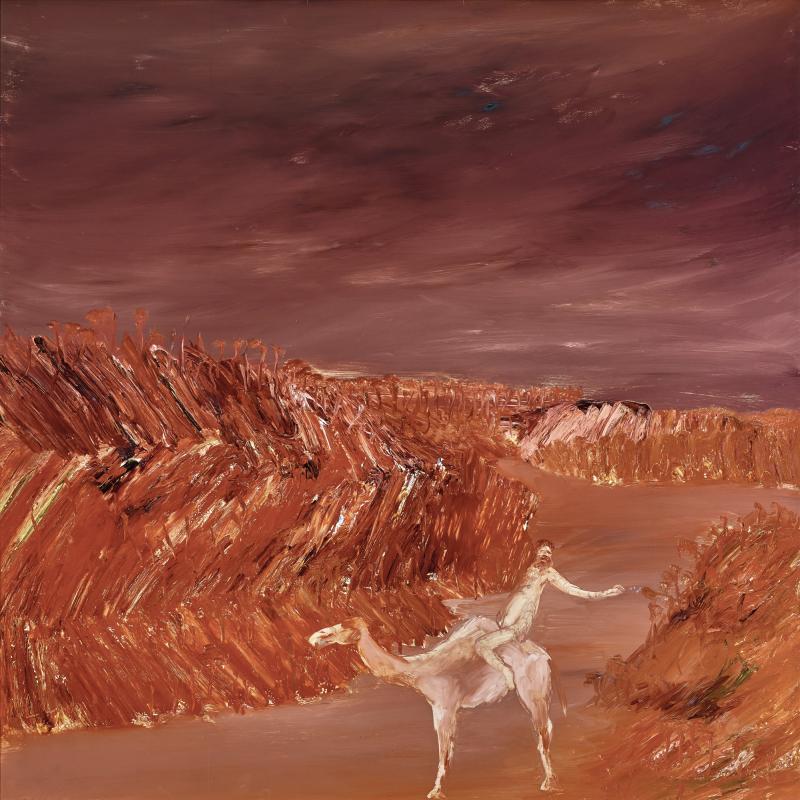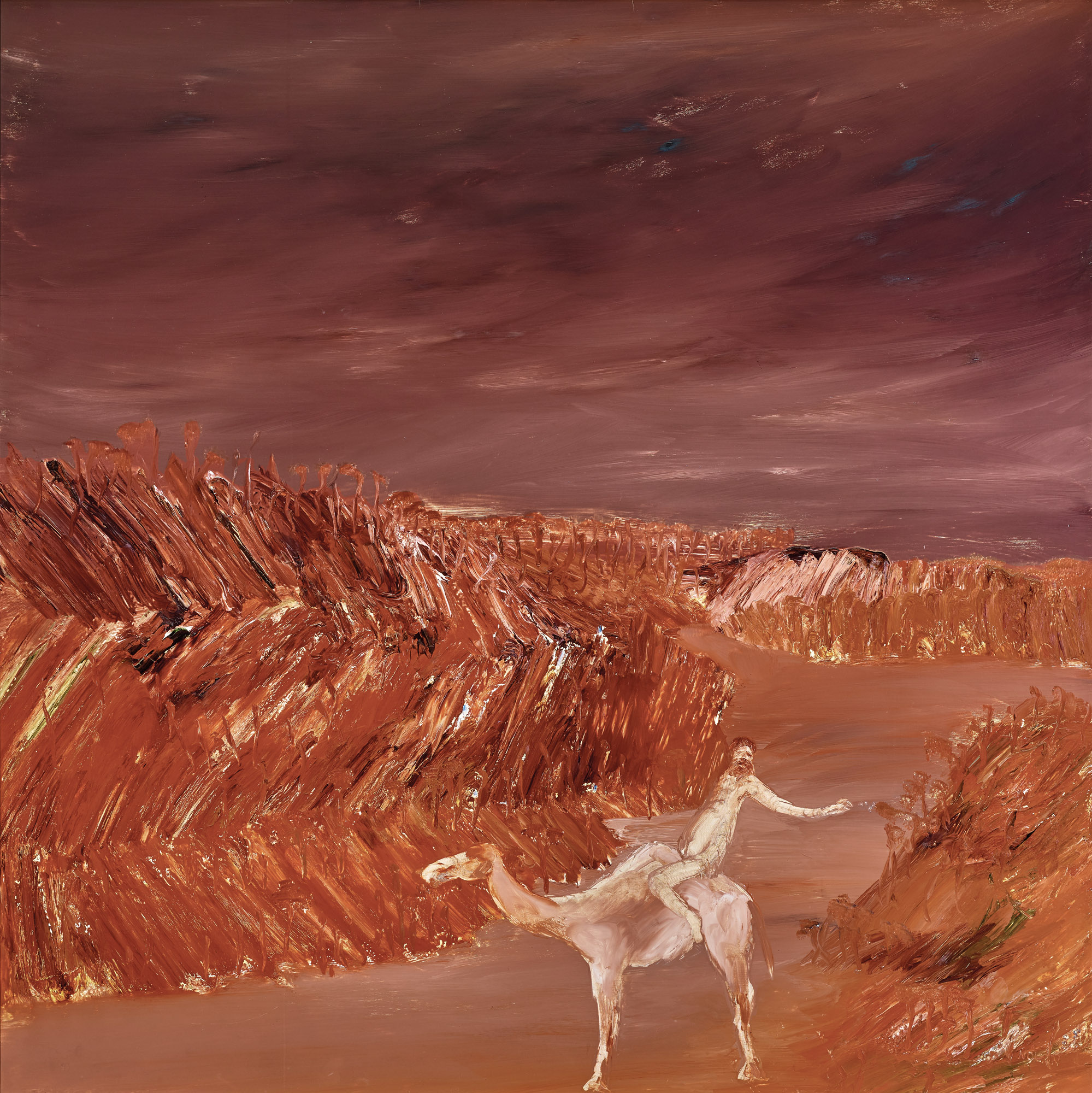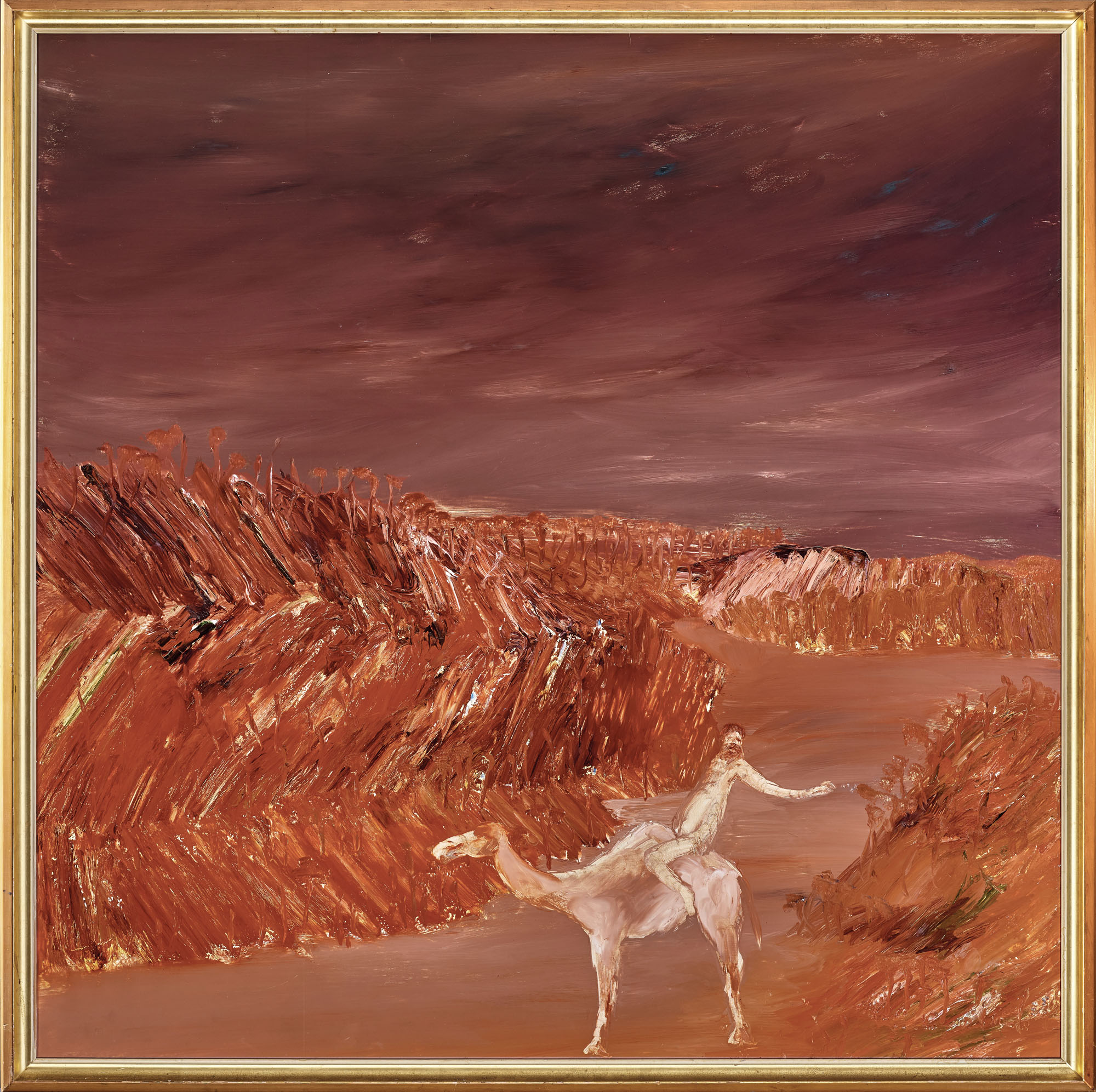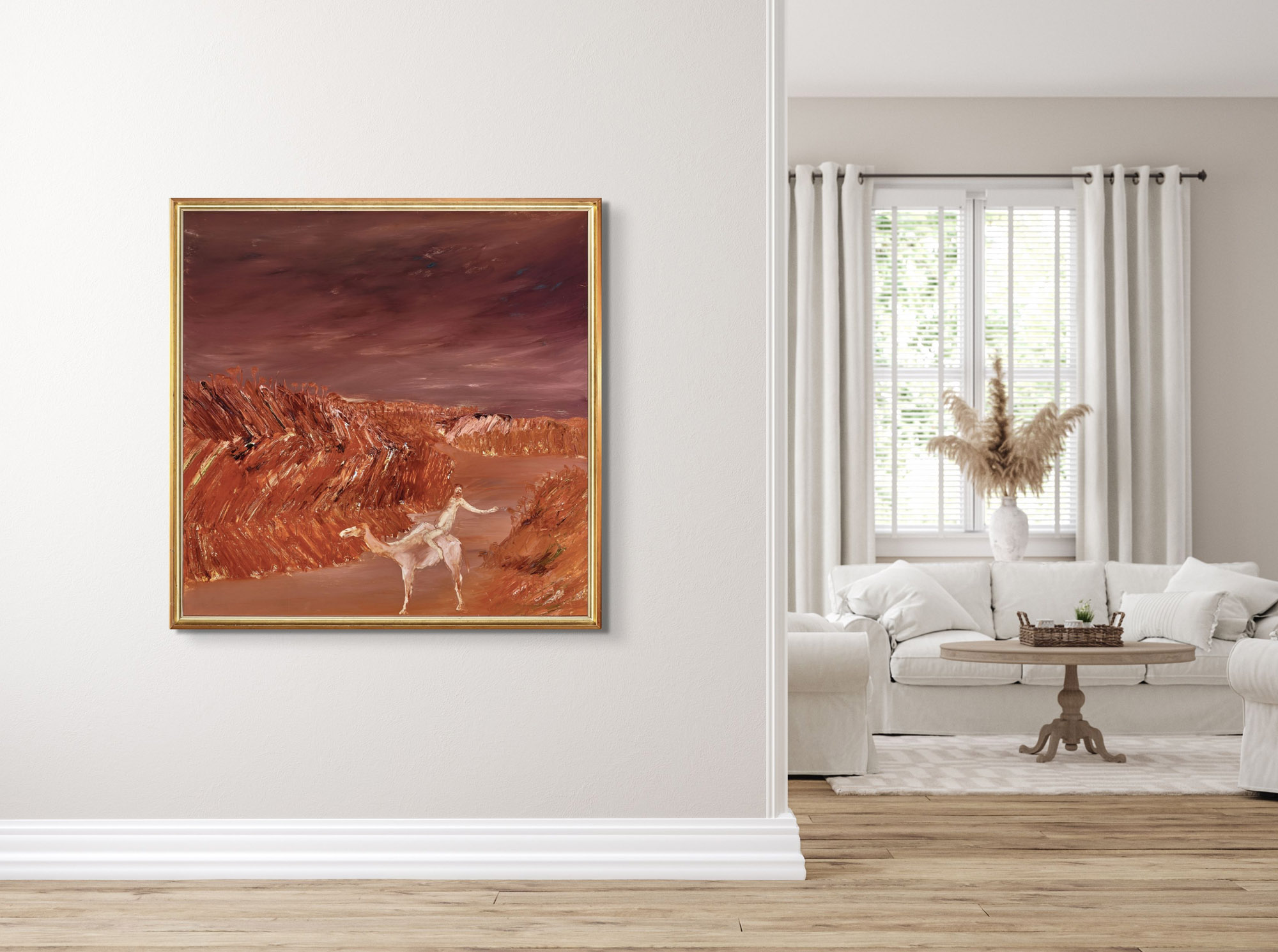SIDNEY NOLAN (1917-1992)
Burke and Camel c1966
Estimate: $140000 - 180000
Description
SIDNEY NOLAN (1917-1992)
Burke and Camel c1966
oil on board
120.0 x 120.5 cm; 128.5 x 128.5 cm (framed)
signed lower right: NOLAN
Provenance:
Marlborough Fine Art, London (as Figure in Landscape, label attached verso)
Savill Galleries, Sydney (label attached verso)
Bridget McDonnell Gallery, Melbourne (label attached verso)
Private collection, Melbourne
Menzies, Sydney, 10 December 2015, lot 38
Private collection of Mr Rodney Menzies, Melbourne
Estate of the above
Exhibited:
Modern Australian Paintings, Bridget McDonnell Gallery, Melbourne, 8-29 September 1989, cat.18 (illus. exhibition catalogue)
Estimate: $140000 - 180000
Sidney Nolan pursued vigilantly throughout his career the notion of man pitted against the extremities. Nolan was particularly interested in the stories of 19th century explorers including Edward Eyre, Ludwig Leichhardt, Robert O'Hara Burke and William John Wills and their respective treks through the Australian outback and top end.
Nolan painted his first Burke and Wills picture in 1948 and returned to the subject throughout the 1950s, 60s and 80s. Burke and Camel c1966 dates to a particularly productive period of Sidney Nolan’s art; it takes the fraught relationship of man and nature to an altogether new plane. The painting features an apocalyptic conflagration of dirt, rock and grit baked hard by the sun in alizarin crimson and white. The familiar bearded, though now naked, figure of Burke is depicted sitting astride a camel as he makes his way across a hostile desert interior. His sense of being alone in the wilderness is exacerbated by the unrelenting heat and cruel conditions that he and his party faced.
Australia's European exploratory history is peppered with tales of disappointment and tragedy. The Burke and Wills story is perhaps one of our greatest tragedies because, mostly, it could have been avoided. A man of his times, Burke struggled with the idea of being dependent on the Aboriginals whom he considered his inferiors. He jeopardised the party's relationship with them by rudely refusing gifts of food. Not listening to his Aboriginal guide, Dick, or taking heed from the example of the Yantruwanta people, Burke and Wills ultimately perished from the poisonous effect of ill-prepared fern (nardoo) spores and starvation.
Sidney Nolan constantly reinvented and reworked his ideas and, in the process, brought new insights, permutations and ideas into play. Like the equally memorable images that depict Ned Kelly, he was to continue with the Burke and Wills theme throughout his life. In 1964 and again in 1966, Nolan painted Antarctic explorers, the Ned Kelly story and the legend of Burke and Wills. Strong visual correlations were established between each subject, including characteristic motifs that he included in each body of works. Nolan greatly admired the character and resilience of explorers (and bushrangers) and the way they drew on their strengths and ambitious aims. He wrote to the poet and writer Geoffrey Dutton: ‘I doubt that I will ever forget my emotions when first flying over Central Australia, and realising how much we painters and poets owe to our predecessors the explorers, with their frail bodies and superb will-power.’1
Burke and Wills set out from Melbourne to the Gulf of Carpentaria in a party of 19 men in 1860-61. The aim was to cross Australia from south to north by traversing much of inland Australia. Due to poor preparation and management the expedition was doomed from the start.
In the famous ‘dash’ for the Gulf of Carpentaria ordered by Burke; he, Wills, John King and Charles Gray broke away from the main party with six camels, one horse and enough food for just three months. Finding that they could not reach the ocean because of the camels becoming immersed knee-deep in the mangrove swamps, Burke and Wills left the camels behind and proceeded by foot. In a cruel twist they had to turn back around five kilometres short of the coast. The incessant mid-summer heat, the onset of the wet and a lack of supplies meant that the return journey to Cooper Creek was even more arduous and harsh.
Burke and Camel c1966, and a related work from London’s Tate Gallery entitled Camel and Figure 1966, capture the double-edged nature of the explorers’ ambition and their heroic but ultimately foolhardy quest. These works seem to allude to the final days of the mission when, after leaving the infamous Dig Tree, Burke and his remaining companions laboured to travel more than eight kilometres a day. One of the two remaining camels, Landa, became bogged in a waterhole and the other, Rajah, was shot when he could travel no further. Without pack animals, Burke, Wills and King were unable to carry enough water to leave Cooper Creek and cross the Strzelecki Desert to Mount Hopeless. Their supplies were running low and they were malnourished and exhausted.
Nolan told Ronald Alley, former Keeper of Modern Pictures at the Tate Gallery, that the naked explorer was Burke because he was more manic and flamboyant than Wills. In these terms Burke is the archetypal explorer who risks all to chart ‘new’ territory and seek out ‘some wilderness plot, unviolated by man’.2 As has been eloquently described by art historian Jane Clark, in relation to Camel and Figure, ‘Man and beast are insubstantial, ghostly figures. They are not painted; but scraped out of the landscape itself – with scarcely more than a swish.’
The reduced state of Burke and the feeling that his nakedness is a premonition of impending death finds its counterpoint in the surrounding landscape that is both imagined and real. Strangely, the white iridescent area in Camel and Figure is based on a salt lake in South Australia that was not actually on the route taken by Burke and Wills in 1860. In this context the illusion of water offered cruel hope. In Burke and Camel there is not even the suggestion of ground water and the landscape echoes other Central Australian compositions painted by Nolan in which nature has been reduced to a series of never-ending ridges, jagged crevices and sun-baked plateaus. These landforms define a smooth path for Burke to follow – perhaps a river bed – that ultimately lead him in a zig-zag pattern such as in a labyrinth or maze. The diagonal brushstrokes and stripes prominent in each ridge reinforce the visual notion of an impenetrable barrier and the futility of his journey.
Painted in the same year as the seven-panel opus Desert Storm 1966, now in the Art Gallery of Western Australia collection, Camel and Figure introduces a new desert lexicon into Nolan’s art in which, ‘paint becomes the presence of sand, stone outcrop and scrub’.3 It is a landscape of fiery heat, intense light and unending space. The rich glow of the sky and redness of the dirt are omnipresent and the sepia tones reference photographs that had been taken of Burke and Wills as they left Melbourne at the beginning of their onerous trip. There is the overriding impression of an ancient, vast and timeless land and of resilience in the face of adversity. However, the experience of Burke encapsulated in this painting also projects Nolan’s belief that life’s journey is fraught with both adventure and peril.
Footnotes
1. Sidney Nolan in correspondence with Geoffrey Dutton, quoted in Clark, J., Sidney Nolan Landscapes and Legends: a Retrospective Exhibition 1937-1987, National Gallery of Victoria, Melbourne, 1987, p.95
2. Rosenthal, T.G., Sidney Nolan, Thames and Hudson, London, 2002, p.120
3. Patrick Hutchings quoted in Clark, J., op. cit., p.159
Rodney James
Rodney James is an independent art consultant who specialises in valuations, collection management, exhibitions, research and writing, and strategic planning for art galleries and museums.
Specialists
-

Cameron Menzies, Chairman & Head of Private Sales
cmenzies@menziesartbrands.com
+61 (0) 466 636 142 -

Asta Cameron, Art Specialist
acameron@menziesartbrands.com
+61 (0) 400 914 088 -

Clementine Retallack, Front of House Manager & Associate Art Specialist
cretallack@menziesartbrands.com
+61 (0) 478 493 026
Location
Sale & Exhibition Details
-
Auction
27 March 2024
6:30PM AEDT
1 Darling Street
SOUTH YARRA VIC 3141
artauctions@menziesartbrands.com -
Exhibition
-
Sydney
14-17 March 2024
10:00AM to 5:00PM AEDT
12 Todman Avenue
KENSINGTON NSW 2033
art@menziesartbrands.com -
Melbourne
21-26 March 2024
10:00AM to 5:00PM AEDT
1 Darling Street
SOUTH YARRA VIC 3141
artauctions@menziesartbrands.com
-



